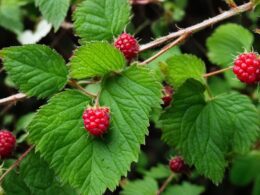Blackberry plants, scientifically known as Rubus fruticosus, are perennial plants that produce delicious aggregate fruits. The blackberry life cycle consists of two types of canes – primocanes and floricanes. Floricanes are the canes where blooming and fruiting occur.
Blackberry plants typically bloom in late spring to early summer, with the exact timing depending on location and temperature. The flowers are small and white, with some varieties having a hint of pink. These blooms are essential for fruit formation, as they are pollinated by bees and other insects. Without blooms, there would be no berries!
To encourage more blooms, blackberry plants require full sunlight, regular watering, and a balanced fertilizer in early spring.
Knowing when blackberries bloom is crucial if you want to enjoy a bountiful harvest of these juicy fruits. By understanding the blackberry season, you can plan your gardening activities and ensure that you have ripe, plump berries to enjoy.
Stay tuned to learn more about growing blackberries at home and how to savor their flavor all summer long.
Tips for Growing Blackberries at Home
If you want to have access to fresh and handpicked blackberries all summer, it’s best to grow your own blackberry bushes at home. While wild blackberry plants may seem tempting, they can be invasive and difficult to control. Instead, buy blackberry plants from a reputable nursery or plant vendor. By growing your own plants, you can choose where to plant them and avoid the hassle of getting scratched by thorny vines. You can also select thornless and pest-resistant varieties for easier maintenance. If you have limited space, consider growing blackberries in containers. Thornless and erect varieties like Arapaho and Kiowa are ideal for small spaces and patios. Just remember that potted plants require more care, including regular watering, fertilizing, pruning, and winter protection.
- Choose a sunny location: Blackberries thrive in full sunlight, so select a spot in your garden that receives at least six to eight hours of direct sunlight each day.
- Prepare the soil: Blackberry plants prefer well-draining soil with a pH level between 5.5 and 7.0. Incorporate organic matter, such as compost or aged manure, into the soil to improve its fertility and drainage.
- Planting and spacing: Dig a hole that is wide and deep enough to accommodate the roots of the blackberry plant. Space the plants 3-4 feet apart in rows that are 8-10 feet apart. This allows air circulation and reduces the risk of disease.
- Provide support: Many blackberry varieties require support to keep the canes upright. Install a trellis, fence, or wire system for the canes to grow on. This will make harvesting easier and protect the canes from damage.
- Water regularly: Blackberry plants need consistent moisture, especially during fruit development. Water deeply once a week, providing about 1 inch of water. Avoid overwatering or waterlogging the soil.
- Fertilize appropriately: Apply a balanced fertilizer or compost in early spring as new growth begins. Follow the manufacturer’s recommendations for the specific fertilizer you choose.
- Pruning: Prune blackberry plants in late winter or early spring to remove dead, damaged, or disease-ridden canes. This promotes new growth and improves airflow within the plant.
- Pest and disease management: Monitor your blackberry plants regularly for signs of pests or diseases. Use organic or chemical controls as needed to protect the plants from damage.
- Winter protection: Protect your blackberry plants from freezing temperatures by covering them with a layer of mulch or straw. This insulates the roots and prevents winter damage.
By following these tips, you can successfully grow your own blackberries and enjoy the satisfaction of harvesting homegrown berries all summer long.
Enjoying Blackberries in the Summertime
Blackberrying in the summertime is a favorite pastime for many. From May to September, you can find patches of picking blackberries in the wild or at farmers’ markets. Picking your own blackberries adds to the specialness of the fruit. If you can’t go picking, you can always buy them at local grocery stores, although they may not have the same intense flavor as locally grown berries.
Blackberries are not only great for enjoying fresh but also for making delicious treats like cobblers, cereal or ice cream toppings, and homemade jam. The juicy and sweet-tart flavor of blackberries brings back summer memories of sunny days spent exploring nature and enjoying the outdoors.
If you’re looking for some blackberry recipes to try, here are a few ideas:
- Blackberry Cobbler: A classic dessert that combines the sweetness of blackberries with a buttery and flaky crust.
- Blackberry Parfait: Layer fresh blackberries with yogurt or whipped cream and top with granola for a refreshing summer treat.
- Blackberry Jam: Preserve the goodness of blackberries by making your own homemade jam. Spread it on toast or use it as a filling for pastries.
Whether you pick them yourself or buy them from the store, blackberries are a quintessential taste of summer. So go out and enjoy the season by savoring the delectable flavors of fresh blackberries.
Do Blackberry Plants and Potato Plants Have Similar Growing Seasons?
Yes, both blackberry plants and potato plants have similar growing seasons. They both thrive in well-drained, fertile soil and require ample sunlight. However, their potato plant appearance characteristics are quite different, with blackberry plants being thorny and vine-like, while potato plants have distinctive leaves and flowers.
Conclusion
Growing and harvesting blackberries can be a rewarding experience. With the right knowledge and care, you can enjoy a bountiful harvest of homegrown berries throughout the summer. Blackberry plants thrive in full sunlight and require regular watering to produce plump and juicy fruits.
When it comes to starting your own blackberry patch, it’s important to choose plants from reputable sources. This ensures that you get the right variety for your needs and avoids the risk of invasive species taking over your garden. By purchasing quality blackberry plants, you can confidently nurture them into thriving bushes that will provide you with an abundance of delicious berries.
Having a homegrown blackberry harvest means you’ll have easy access to fresh and flavorful berries without having to venture out. Whether you prefer to pick the ripe berries straight from the vine or purchase them from local farmers’ markets, the joy of savoring these dark gems is unparalleled. From enjoying them as a summertime snack to incorporating them into mouthwatering recipes, blackberries bring a burst of natural sweetness to your culinary creations.
So why not seize the opportunity to create your own blackberry patch and embark on your own blackberry-growing journey? Not only will you experience the satisfaction of nurturing and harvesting your own plants, but you’ll also be able to enjoy the unbeatable taste of homegrown berries all season long. Start growing your own blackberry plants today and indulge in the abundant summer harvest that awaits you.









